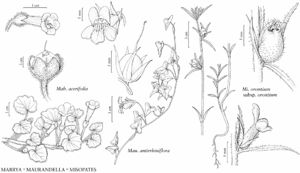Mabrya acerifolia
Syst. Bot. Monogr. 5: 58. 1985.
Plants 10–40 cm, cespitose. Leaves: petiole 12–45 mm; blade reniform, 12–24 × 15–35 mm, surfaces glandular-hairy. Pedicels ascending in flower, 8–25 mm, thickened and recurved in fruit. Flowers: sepals equal, 6–8 × 3–5 mm, apex acute, glandular-hairy; corolla tube 14–21 mm, glandular-hairy, throat open, palate not inflated, abaxial plicae dark yellow, lobes equal, 2–4 mm, apex round; stamens included, filaments incurved, hairs at base and apex clavate, abaxial 9–11 mm, adaxial 11–13 mm, pollen sacs oblong; ovary glabrous, locules subequal; style included, 10–12 mm, base persistent in fruit; stigma recurved. Capsules globular, 7–9 mm. Seeds 1–2 mm, tuberculate to cristate. 2n = 24.
Phenology: Flowering Feb–May.
Habitat: Rock walls, canyons, cliffs, roadcuts.
Elevation: 200–1000 m.
Discussion
Mabrya acerifolia is easily identified vegetatively and in flower or fruit by its cespitose habit on rock walls, dense covering of glandular hairs, reniform leaves with dentate margins, ochroleucous to yellow corollas with yellow plicae, and globular capsules on recurved pedicels. The species is endemic to south-central Arizona in Maricopa and Pinal counties within a 30 km radius of the type locality.
Selected References
None.
